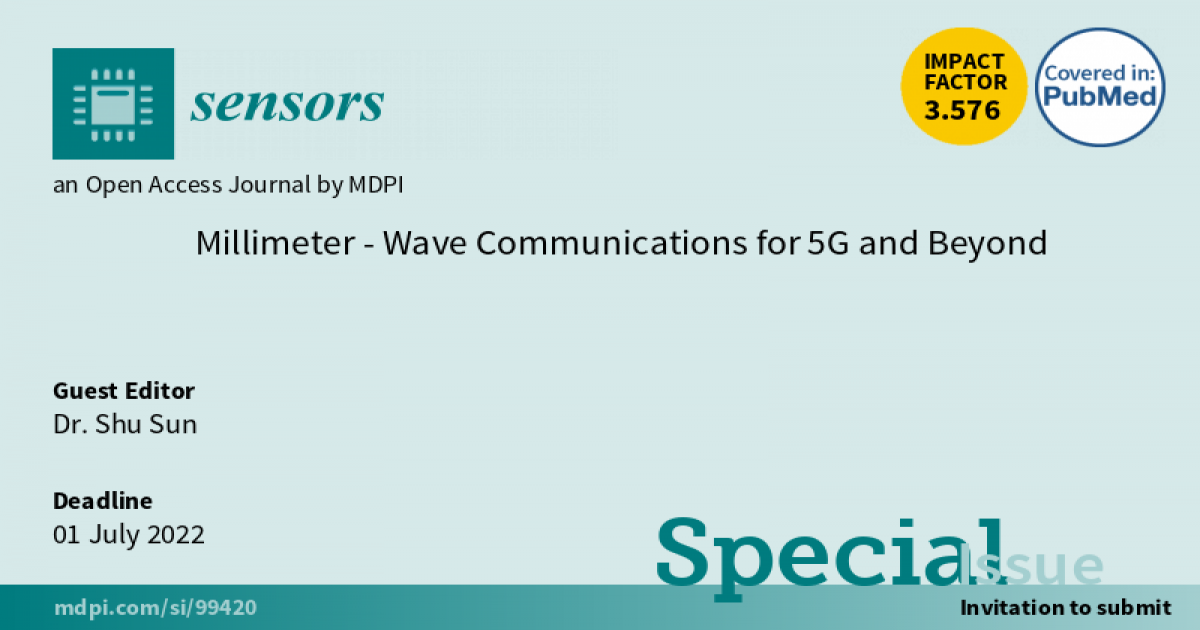Millimeter-Wave Communications for 5G and Beyond
A special issue of Sensors (ISSN 1424-8220). This special issue belongs to the section "Communications".
Deadline for manuscript submissions: closed (1 July 2022) | Viewed by 3896

Special Issue Editor
Special Issue Information
Dear Colleague,
With the advent of global commercial deployment of 5G, the important role of millimeter wave (mmWave) (around 30 GHz – 300 GHz) in wireless communications is becoming more evident. MmWave is able to offer unprecedentedly high data rates, high localization and sensing accuracy, and reduced interference due to the abundant bandwidth, tiny wavelength, and the utilization of directional beamforming, respectively, among other benefits. The propagation characteristics and potential beamforming techniques for mmWave have been extensively studied in various scenarios, and the channel models for frequencies up to 100 GHz for terrestrial cellular networks have been standardized in 3GPP specifications.
Nevertheless, the deployment of 5G mmWave systems still face a plurality of challenges, such as the realization of practical mmWave transceiver modules and beamforming architectures, lack of standardized channel models for vehicular-to-everything (V2X) and non-terrestrial mmWave communications, backward compatibility with microwave systems, etc. Furthermore, there are numerous opportunities and research directions for mmWave in beyond-5G (B5G)/6G systems; for instance, the combination with massive antenna arrays or intelligent surfaces, employment of artificial intelligence, and joint communication and sensing in particular.
This Special Issue aims to highlight the deployment challenges and solutions for 5G mmWave systems, and emerging applications of mmWave in B5G/6G. Prospective authors are invited to submit original contributions on, but not limited to, the aforementioned aspects.
Dr. Shu Sun
Guest Editor
Manuscript Submission Information
Manuscripts should be submitted online at www.mdpi.com by registering and logging in to this website. Once you are registered, click here to go to the submission form. Manuscripts can be submitted until the deadline. All submissions that pass pre-check are peer-reviewed. Accepted papers will be published continuously in the journal (as soon as accepted) and will be listed together on the special issue website. Research articles, review articles as well as short communications are invited. For planned papers, a title and short abstract (about 250 words) can be sent to the Editorial Office for assessment.
Submitted manuscripts should not have been published previously, nor be under consideration for publication elsewhere (except conference proceedings papers). All manuscripts are thoroughly refereed through a single-blind peer-review process. A guide for authors and other relevant information for submission of manuscripts is available on the Instructions for Authors page. Sensors is an international peer-reviewed open access semimonthly journal published by MDPI.
Please visit the Instructions for Authors page before submitting a manuscript. The Article Processing Charge (APC) for publication in this open access journal is 2600 CHF (Swiss Francs). Submitted papers should be well formatted and use good English. Authors may use MDPI's English editing service prior to publication or during author revisions.
Keywords
- millimeter wave
- 5G
- 6G
- channel model
- beamforming
- sensing
- joint communication and sensing
Benefits of Publishing in a Special Issue
- Ease of navigation: Grouping papers by topic helps scholars navigate broad scope journals more efficiently.
- Greater discoverability: Special Issues support the reach and impact of scientific research. Articles in Special Issues are more discoverable and cited more frequently.
- Expansion of research network: Special Issues facilitate connections among authors, fostering scientific collaborations.
- External promotion: Articles in Special Issues are often promoted through the journal's social media, increasing their visibility.
- Reprint: MDPI Books provides the opportunity to republish successful Special Issues in book format, both online and in print.
Further information on MDPI's Special Issue policies can be found here.






